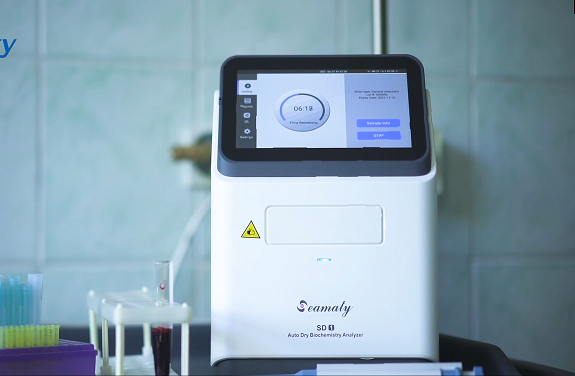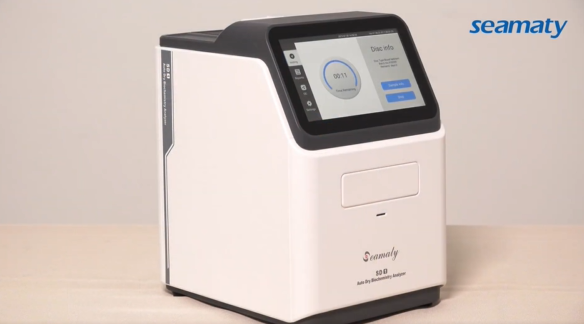1. The development and general principle of blood testing machines
The earliest blood testing machines were based on the principles of capacitance and photoelectric colorimetry, which could only determine red blood cells and white blood cells, and were susceptible to interference from a variety of factors.
In 1948, Mr. Coulter adopted the principle of impedance to determine the organic fraction of blood. This improved the precision and accuracy of the results to a great extent. However, the impedance method could only determine the size of the cells.
In the 1980s, the laser principle was used in blood testing machines, and the impedance method was combined with the laser method. This
blood analyzer was able to determine not only the size of cells but also the morphology of the nucleus.
In the mid-1980s, due to the development of high-energy electromagnetic wave technology, the U.S. company Inventory used impedance, laser and high-energy electromagnetic wave technology to detect a cell at the same time, and then cell sorting by comprehensive analysis of the data. Because the high-energy electromagnetic wave technology can detect the size and density of the particles inside the cell. There is also the German company Bayer, which uses the principle of combining cytochemical reactions with laser technology to sort and detect leukocytes.
Since neutrophils are rich in peroxidase in their cytoplasm, monocytes are second, primitive cells are very rare, and lymphoid and basophils lack this enzyme. Therefore, the hematology analyzer can classify neutrophils with lymphatic and basophils using the action of peroxidase.
Flow cytometric analysis is also used to count and classify reticulocytes. Toa also classifies naive cells by using the principle that the amount of lipid content on the membranes of naive and mature cells is different and the amount of sulfated amino acid binding by the cell membranes is different, and the ability to protect the cell membranes is different after adding hemolytic agents.
With the development of science and technology, the detection method of blood testing machines will certainly be more perfect and more accurate.

2. Common failures of blood testing machines
In addition to some relatively large failures, such as negative pressure pump into the water, peristaltic pump weakness, counting errors or not counting at all, etc. need the manufacturer's engineers to repair. In fact, many small faults can be solved by yourself.
Some common failures: such as counting small hole clogging, sample needle clogging, pump tube aging, filter is not smooth, directional valve failure, solenoid valve clogging, waste liquid cup accumulation, insufficient reagent volume and sample volume of the shortage and so on.
3. Find blood testing machine fault methods and treatment
For general failures, most of the higher grade hematology analyzers currently have fault tips and troubleshooting tips. These faults are generally easy to solve, and most of them can be solved by following the methods indicated by the instrument. For example, a certain reagent out of range, insufficient sample volume, etc..
There are also some tips that are just a phenomenon. For example, counting error, because there are a variety of factors can lead to counting error, such as the amount of reagents or sample volume is not enough, the pipeline is blocked, the filter is not smooth, the counting hole is blocked, the vacuum pump into the water, computer program error, etc. can lead to counting error. Therefore, when such errors occur, we need to check them one by one to find out the causes of the errors and then solve them.
You can also test certain fixed parameters of the blood testing machine to understand the possible problems of some parts of the instrument. This requires us to understand the general performance of the instrument and certain specific parameters. Based on the changes in parameter values to determine where the problem lies or which system. For example, we can know the condition of the vacuum pump by measuring the pressure, whether the filter is clogged, whether the directional valve is out of order, etc.
There are some faults that the instrument neither indicates nor can be understood by testing. We only through the blood testing machine by the appearance of certain phenomena carefully observed and analyzed, in order to understand the cause of the failure. For example, we often encounter in the work of the instrument can not detect the reagent. This is just a phenomenon there are a variety of reasons can lead to the emergence of this phenomenon. For example, peristaltic pump weakness, pump tube aging, filter use for too long, pressure reduction, pipe blockage, sensor failure, etc. can lead to the emergence of this phenomenon.
In addition, such as blood testing machine suddenly can not be counted blood cells. The reasons for this include: blockage of the counting orifice, failure of the electronic valve or directional valve, backflow of waste liquid into the negative pressure pump due to the accumulation of liquid in the waste liquid cup, external magnetic interference, etc. can cause the instrument not to count. Therefore, when checking certain faults of the instrument, it is necessary to check all factors one by one to find out the causes of the faults and then to eliminate them.
Some faults may also be caused by unstable voltage or poor grounding. For example, the counting time is prolonged, the program is wrong, and the instrument is dead. This can usually be resolved by adding a regulated power supply, checking the ground, or restarting.
Any one blood testing machines are composed of thousands of parts of various sections. The more automated and more functional it is, the more components it has and the more complex it is. But for an instrument it is a whole, as long as a part of the problem, will certainly affect the other parts. Therefore, when we check the blood testing machines failure, to take a holistic view, to take into account all aspects of the factors.



